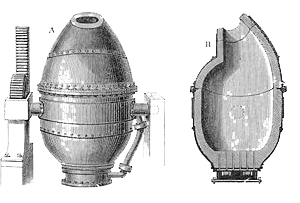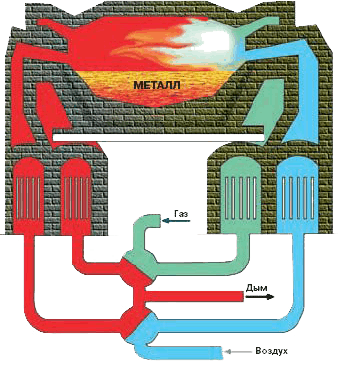
Many factors influence on human development, but one of the most important is the material base, which serves as the industrial backbone of any society.
Despite the fact that the iron has been known since the dawn of time, qualitative breakthrough in his treatment began with the invention of technology for production of liquid iron and steel. Appeared Bessemer process, which allowed to satisfy the increased volume of machine industry, but soon discovered serious shortcomings of Bessemer steel. This steel contains nitrides, sulfur and phosphorus. The mechanical properties of this steel ceased to satisfy the industry. Also, began to collect scrap metal.
The next stage of the production of liquid metal marked by the appearance of open-hearth (martin) remelting process, which had solved many problems. However, most importantly, to ensure the provision of clean, homogeneous in composition of the liquid steel in the melting furnace is very difficult, and sometimes impossible. Industry has overtasked the society: to develop the technology and the method of its implementation, in the refining of molten steel from non-metallic inclusions and dissolved gases, evenly distribute introduced additives and control the properties of the finished steel.

The theory developed by Geller (Geller W., Sun T.H. –«Arch. Eisenhuttenwesen», 1950, Bd 21, №8, S. 423-426) showed that the most viable and promising, is the blow-down of melt in the ladle by gases, in fine bubble mode. Wherein the bubbles would not compete with each other, which is the most advanced surface of mass transfer. It seems to be "take it and blow", but there was nothing to take - no blowing devices. There was offered different exotics, however there wasn’t the real form for the fulfillment of these conditions. As an alternative, it was offered blowing plugs. And although they were far from the theoretical ideal, but it was something that can be fed the gas through to the ladle. In this the blow-down took place in local mode, the gas flow is limited by replacement of the bubble mode for the jet, the amount of melt processed is insignificant.
Our specialists has been conducted research on the development of technology that would ensure the implementation of the requirements of the theoretical volume fine bubble mode of passage of the gas flow in the melt. The chronology of this research you can find on our website, under the section "Articles".
At present, we have developed and proposed a universal device, consisting of separate sections and collecting into the block, which size is equal of the appropriated metal container. This device provides a fine bubble volumetric mode of blow-down. Besides the distance between the bubbles is that they do not compete with each other, that is completely satisfying theoretical developments of "ideal" blow-down.
The second question, which is engaged in our company is recycling of waste rubber products, mainly tires. Due to the increased volumes of automotive, the number of waste tires increases too, and the problem of their utilization is far from being solved. Existing systems to address this issue are bulky, power consuming and environmentally unsound. Although the "ideal" theoretical frameworks are known, the embodiment has not been implemented.
In the last years, we were making an analysis of existing devices and their shortcomings, whereby it was designed and developed a fundamentally new set for recycling with the method of dry pyrolysis, which performance many times exceeds the analogues, and in the same time fully meet modern environmental standards.
The technology of daisy-chain blow-down of melt (ShPR) based on the effect of gas bubbles do not merge during the passage through the melt in the general flow. The implementation of such an effect can be possible just in case of bulky ejection of liquid bubble during its movement. In the case of a random arrangement of capillaries (porous plugs) or locally arranged slotted capillaries (slot blowing plugs), the ejection by bubble flow occurs at its periphery. The internal volume does not involve in the process of mass transfer. Thus, in order to fulfill conditions of effective process of mass transfer, it is necessary to provide the process of bulky ejection by bubble flow of liquid.
We have developed special blowing device that fully satisfies the requirements of technological processes of hydrodynamics and mass transfer. Blowing device is a rectangle with a width of 100 - 200mm. Pores are arranged linearly (stitch), parallel to each other. The distance between the lines is selected such that to ensure for the ejection the sufficient volume of liquid and the free passage between them. This kind of blowing element called blowing section. Thus, using this section there is maximum mass transfer process.
The gas bubbles out of the capillaries in the form of individual loops. At a sufficient distance between the loops, their one-to- shading is completely absent, that is, the bubbles of gas plume do not compete with each other. Technology of melt blow with stitch capillary section has got the name "daisy-chain blow-down of melt" or ShPR.
Depending on the area of the bottom of a metallurgical vessel, the area of a blowing device must be accordingly greater. We have found that the area of a blowing device must be equal to 0,1 ÷ 0,5 of base area. To ensure this area, the blowing device is collected from the blowing sections. This set of blowers has been called "block of ShPR".
AI Website Generator